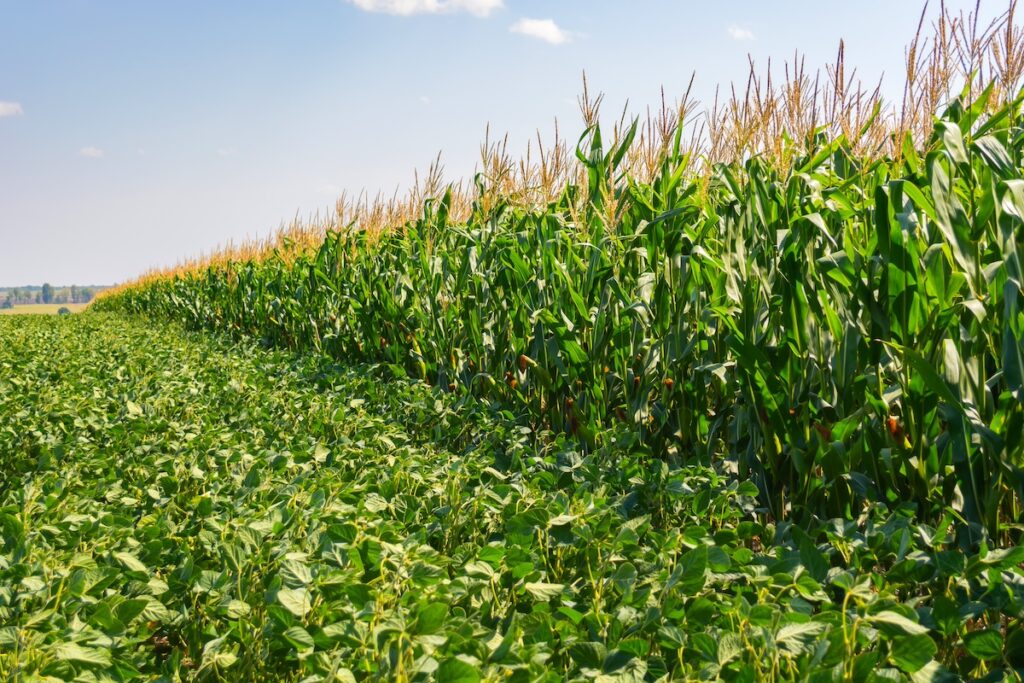Our partner farmers make use of a variety of techniques that boost the health of the soil, not only to produce quality crops for their customers but to ensure that their land can be passed from one generation to the next.
While conventional agriculture might plant corn year after year within the same field, regenerative farmers plant according to a meticulously planned rotation, which takes into account nutrient requirements, water usage, and pest resistance.

Crop rotation and Regenerative Agriculture
Say a farmer has two sections of land on their farm on which they grow their cash crop. In a regenerative system, section A would start as corn while section B a different crop such as soybeans. In year two, the two sections would switch, with corn planted in section B and soybeans in section A. The third year, the sections would revert to the first-year format, or perhaps add an additional third rotation crop like oats or wheat. In order to produce a crop, plants like corn and soybeans take up their nutrients and water from the soil. When planted year after year in the same section, these crops can end up using all the available nutrients, depleting the soil of certain elements. Crop rotation, in combination with manure additions and following other regenerative agricultural practices, gives the soil system the needed resources for sustainable agriculture.

Benefits of Crop Rotation
Planting the same crop in the same place every year, known as monoculture, not only draws vital nutrients out of the soil but also encourages pests and pathogen issues. Through crop rotation, pests that plant their eggs on the leaves or roots of a host crop hatch the next year to find that their host food source has been removed, thereby breaking the pest cycle that plagues many farmers.
According to The Center for Regenerative Agriculture and Resilient Systems at California State University, Chico, crop rotation has myriad benefits, including:
- Increased soil quality, fertility, and organic carbon
- Improved soil microbiology
- Increased biodiversity
- Reduced need for pesticides and fertilizers
- Increased carbon addition to the soil of farm fields
A key concept to remember is that crop rotation helps improve yields. Studies have shown that corn grown in a two-year rotation with soybeans yields 5 to 20 percent more than growing corn year after year.
For Gevo, that means every corn stalk planted can provide more high-quality animal feed and feedstocks for bio-based renewable fuel, reducing the total amount of land needed to produce sustainable fuels.
Crop Rotation and Crop Diversity: A Win-Win for Farmers and Fuels
Crop rotation is part of the soil health practices and farmers can also utilize crop rotation to diversify their operations and protect their bottom lines.
Instead of planting a monocrop of corn year after year, integrating a second or third crop such as soybeans, oats, wheat, or sunflowers can help farmers from a business perspective as well:
Planting a diversified portfolio of crops gives the farmer an additional stream of income in a different market, allowing them to become less reliant on the variable prices of one crop.
Farmers with multiple cash crops reduce their risk of pest- and weather-related losses, as different plants are susceptible to different pathogens.
By allowing their subsequent crop to put nutrients back in the soil, farmers can cut down their costs on inputs like fertilizers. A study conducted by Iowa State University showed that longer diversified crop rotations, fertilizer application was 88 to 92 percent lower.
Crop Rotation: The Bottom Line
Gevo’s bio-based renewable fuel model relies on growing strong, healthy, and abundant plants that have the necessary components to create both high-protein animal feed and starches for feedstock.
Alongside helping farmers maintain their livelihoods and adding additional products to the harvest, building healthy soil with crop rotation is an easy choice to make.
